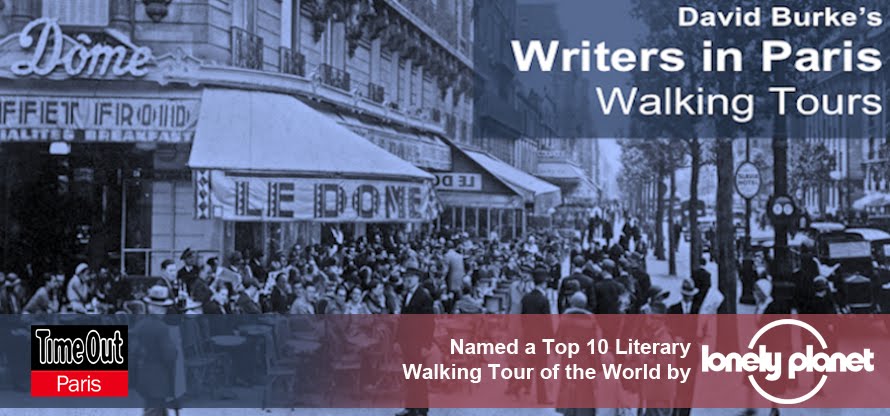I’m fascinated by the relationship of people and their places, especially when it comes to writers in Paris -- where they were and what they did there. Take this photo from 1922. \From left to right, they are Ford Madox Ford, James Joyce, Ezra Pound, and Joyce’s lawyer John Quinn. I knew that it was photographed in front of the big wooden door to Pound’s atelier at No. 70, bis, rue Notre Dame-des-Champs in Montparnasse. I had stopped at the sturdy steel street gate there many times during my “Lost Generation” literary walking tours, but must to my frustration the sturdy steel gate was always closed, making it impossible to go in and see Ezra Pound’s place. But then last November when I was doing a walk with four jolly Swedes, the steel gate was wide open. Construction work was going on. I was through the gate with a flash, with my team of Scandinavians racing behind, down the long, narrow corridor to the little courtyard in front of Pound’s atelier, where modernization was going on.
At last I know where it was. Note the bulky wooden door in the 1922 photo with Ezra Pound and his visitors and look at the one of me standing before that same wooden door in November 2014.
Here are the photos from last year:
Poet, editor, and all-round cultural gadfly, Ezra Pound lived with his artist wife, Dorothy
Shakespear, at No. 70, bis, rue Notre Dame des Champs from the summer of 1921 until the winter of 1924.
A brilliant and omnivorous student and translator of ancient poetry, including Chinese and Japanese verse, this Idaho-born American settled in London in 1908, where he wrote influential poetry (“In a Station of the Metro,” and the Hugh Selwyn Mauberly cycle), edited the little magazines Poetry, the Egoist, and Blast, and became a guru to younger poets, most notably H. D. (Hilda Doolittle) and T. S. Eliot. But feeling that London had lost its literary edge (“an old bitch, gone in the teeth”) and having talked James Joyce into moving to Paris, Pound decided that he should be there too. He arrived in December of 1920. Sylvia Beach was in for a surprise when he first paid a visit to Shakespeare and Company:
“His costume—the velvet jacket and open-road shirt—was that of the English aesthete of the period. There was a touch of Whistler about him; his language, on the other hand, was Huckleberry Finn’s.”
The tall, lanky, red-bearded Pound was one of the most influential figures on the expatriate scene as magazine editor, advisor to Bill Bird’s Three Mountains Press, and champion of Joyce and Eliot. In Pound’s words, this was “a grrrreat litttttterary period.” He was also a mentor to Hemingway, giving him lectures on literary style in exchange for boxing lessons. Gertrude Stein was Pound’s only known enemy. She called him “the village explainer, excellent if you were in a village, but if you were not, not.”
He called her “that tub of guts.”
Besides his work for others, Pound started writing his Cantos, the vast cycle of poems that would occupy him for the rest of his life.
After four years, he felt that the city had become too crowded with Americans who were “anything but the Passionate Pilgrims of James’s day or the enquirers of my own.” At the end of 1924, Pound, his wife and his mistress, the concert violinist and musicologist
Olga Rudge, moved to Rapallo, where Rudge had a daughter by him the following year.Pound’s unbridled support of Mussolini, capped by pro-Fascist, anti-Semitic broadcasts during World War II, irremediably tarnished his reputation and led to his incarceration in a Washington, D.C., mental hospital in 1946 (though he could have faced the death penalty for treason). Twelve years later a group of literary supporters, including his old protégés Hemingway and Eliot, successfully petitioned for his release. He returned to Italy, where he died at eighty-seven in 1972.








No comments:
Post a Comment